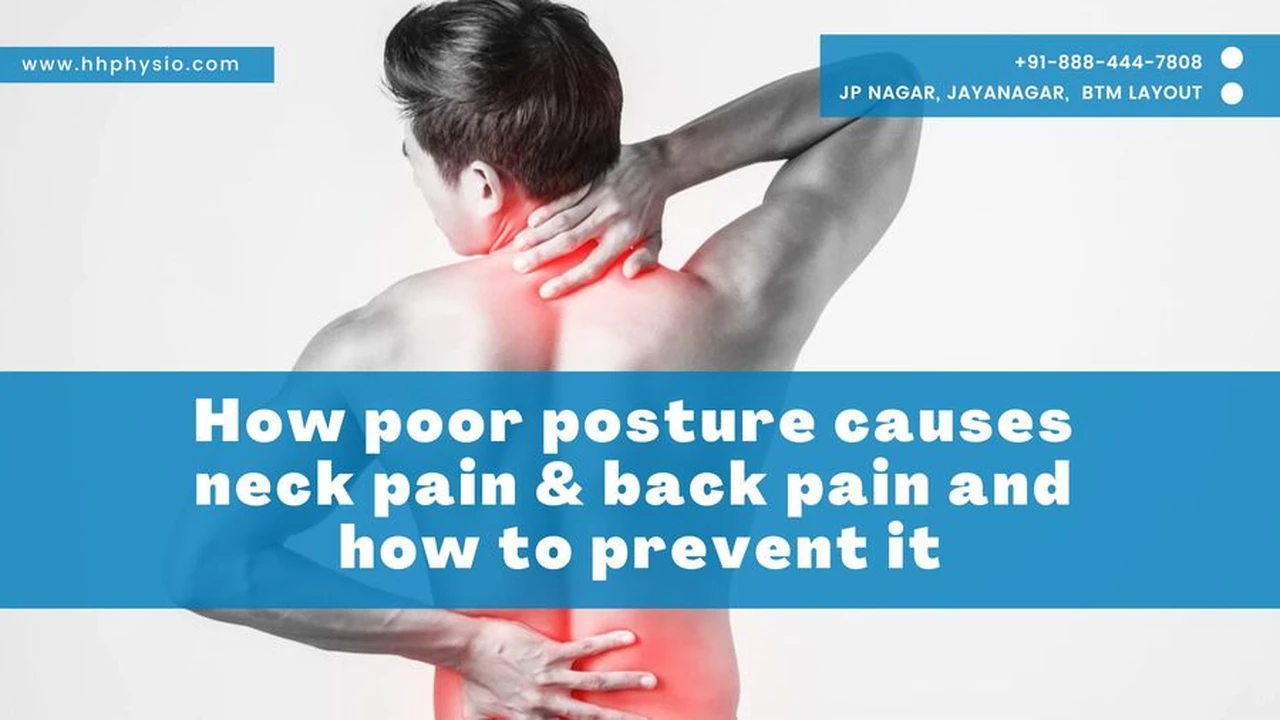How to Prevent Back Pain: Posture and Exercise
Sample meta description.

Understanding Back Pain Causes Risk Factors and Prevention Strategies
Back pain, that nagging ache, the sharp stab, the constant throb – it's something most of us will experience at some point. But why does it happen? And more importantly, what can we do to keep it at bay? Let's dive into the world of back pain, exploring the causes, risk factors, and those all-important prevention strategies. Think of this as your friendly guide to a healthier, happier back.
Common Causes of Back Pain
First things first, let's talk about the usual suspects. Back pain rarely comes out of nowhere. It's often the result of a combination of factors:
- Muscle Strains and Sprains: These are the most common culprits. Overdoing it at the gym, lifting something heavy improperly, or even just a sudden awkward movement can strain or sprain the muscles and ligaments in your back.
- Poor Posture: Slouching at your desk, hunching over your phone, or sleeping in a weird position can put undue stress on your spine.
- Herniated Discs: These are like the shock absorbers between your vertebrae. When they rupture or bulge, they can press on nerves, causing pain, numbness, and even weakness.
- Arthritis: This degenerative joint disease can affect the spine, leading to inflammation and pain.
- Osteoporosis: This condition weakens bones, making them more susceptible to fractures, including those in the spine.
- Sciatica: This refers to pain that radiates along the sciatic nerve, which runs from your lower back down the back of each leg. It's often caused by a herniated disc or bone spur pressing on the nerve.
Risk Factors That Increase Your Back Pain Susceptibility
While anyone can experience back pain, certain factors can increase your risk:
- Age: Back pain becomes more common as we age, likely due to wear and tear on the spine.
- Weight: Excess weight puts extra stress on your back.
- Occupation: Jobs that involve heavy lifting, repetitive movements, or prolonged sitting can increase your risk.
- Smoking: Smoking reduces blood flow to the spine, which can slow healing and increase the risk of disc degeneration.
- Poor Physical Fitness: Weak back and abdominal muscles can contribute to back pain.
- Psychological Factors: Stress, anxiety, and depression can all worsen back pain.
The Power of Posture Correcting Your Alignment for Back Pain Relief
Posture is everything! Seriously. It's the foundation of a healthy spine. Think of your spine as a stack of building blocks. If the blocks are aligned correctly, the structure is strong and stable. But if they're misaligned, the whole thing can wobble and eventually crumble. That's what happens to your back when you have poor posture.
Good Posture Defined Maintaining Spinal Alignment
So, what exactly is good posture? It's all about maintaining the natural curves of your spine. Here's how to check your posture:
- Standing: Stand tall with your head level, shoulders relaxed, and your weight evenly distributed on both feet. Imagine a string pulling you up from the crown of your head.
- Sitting: Sit with your back straight and your shoulders relaxed. Your feet should be flat on the floor or supported by a footrest. Your knees should be at a 90-degree angle.
- Sleeping: Sleep on your side with a pillow between your knees to keep your spine aligned. Avoid sleeping on your stomach, as this can put strain on your neck and back.
Practical Posture Exercises Strengthening Your Core for Better Support
Improving your posture takes practice, but it's worth the effort. Here are a few exercises you can do to strengthen your core and improve your posture:
- Plank: Hold a plank position for 30-60 seconds, focusing on engaging your core muscles.
- Bird Dog: Start on your hands and knees. Extend one arm forward and the opposite leg back, keeping your core engaged and your back straight.
- Cat-Cow Stretch: Alternate between arching your back like a cat and dropping your belly towards the floor like a cow.
- Wall Sit: Lean against a wall with your knees bent at a 90-degree angle. Hold the position for 30-60 seconds.
Ergonomic Tips Creating a Back Pain Friendly Work Environment
Your work environment can have a big impact on your posture. Here are a few ergonomic tips to create a back-friendly workspace:
- Adjust Your Chair: Make sure your chair is adjusted so that your feet are flat on the floor and your knees are at a 90-degree angle.
- Position Your Monitor: Place your monitor at eye level to avoid straining your neck.
- Use a Keyboard and Mouse That Fit Your Hands: Ergonomic keyboards and mice can help reduce strain on your wrists and hands.
- Take Breaks: Get up and move around every 30 minutes to avoid sitting in the same position for too long.
Exercise for Back Pain Relief and Prevention Core Strengthening and Flexibility
Exercise is crucial for preventing and managing back pain. It strengthens the muscles that support your spine, improves flexibility, and reduces stress. But it's important to choose the right exercises and to perform them correctly.
Core Strengthening Exercises Building a Solid Foundation
A strong core is essential for supporting your spine. Here are a few core-strengthening exercises that are gentle on your back:
- Pelvic Tilts: Lie on your back with your knees bent. Gently tilt your pelvis up towards the ceiling, engaging your abdominal muscles.
- Bridges: Lie on your back with your knees bent. Lift your hips off the floor, squeezing your glutes.
- Dead Bug: Lie on your back with your knees bent and your arms extended towards the ceiling. Lower one arm and the opposite leg towards the floor, keeping your core engaged.
Flexibility Exercises Improving Range of Motion and Reducing Stiffness
Flexibility exercises can help improve your range of motion and reduce stiffness in your back. Here are a few stretches to try:
- Knee-to-Chest Stretch: Lie on your back and pull one knee towards your chest, holding the stretch for 30 seconds.
- Piriformis Stretch: Lie on your back with your knees bent. Place your right ankle on your left knee. Gently pull your left thigh towards your chest, holding the stretch for 30 seconds.
- Lower Back Rotation Stretch: Lie on your back with your knees bent and your arms extended to the sides. Gently rotate your knees to one side, keeping your shoulders on the floor.
Low Impact Aerobic Exercise Enhancing Circulation and Reducing Inflammation
Low-impact aerobic exercise can help improve circulation and reduce inflammation in your back. Here are a few options:
- Walking: Walking is a great way to get your heart rate up without putting too much stress on your back.
- Swimming: Swimming is a low-impact exercise that works all the major muscle groups.
- Cycling: Cycling is another low-impact exercise that can help improve your cardiovascular health.
Product Recommendations for Back Pain Management
Okay, let's get to the nitty-gritty! Sometimes, a little help from some well-designed products can make a world of difference in managing back pain. We're not talking magic bullets here, but tools that can support good posture, provide relief, and enhance your overall well-being.
Ergonomic Office Chair Comparison Prices and User Reviews
If you spend a significant amount of time sitting, an ergonomic office chair is a must-have. It's an investment in your long-term back health. Here are a few options, with a focus on adjustability and support:
- Herman Miller Aeron: The gold standard. Offers incredible adjustability, breathable mesh, and exceptional lumbar support. Use Case: Ideal for long workdays, especially for those with pre-existing back issues. Pros: Highly adjustable, durable, breathable. Cons: Expensive (around $1500 - $2000).
- Steelcase Gesture: Another top contender, known for its intuitive adjustments and supportive design. Use Case: Great for those who move around a lot while working or switch between different tasks. Pros: Very comfortable, highly adjustable, excellent build quality. Cons: Also pricey (around $1200 - $1800).
- Hbada Ergonomic Office Chair: A more affordable option that still provides decent support. Use Case: Good for home office use or shorter workdays. Pros: Affordable (around $150 - $300), adjustable lumbar support, breathable mesh. Cons: May not be as durable or as adjustable as higher-end models.
- SIHOO M57 Ergonomic Office Chair: Excellent value for money, with good adjustability and lumbar support. Use Case: A good all-rounder for home or office use. Pros: Affordable (around $200 - $350), adjustable headrest and armrests, breathable mesh. Cons: Some users report that the seat cushion could be more comfortable.
Lumbar Support Cushions Finding the Right Fit for Your Back
If you can't afford a new chair right away, a lumbar support cushion can provide some much-needed relief. These attach to your existing chair and help maintain the natural curve of your spine.
- LoveHome Memory Foam Lumbar Support Cushion: A popular choice made from high-density memory foam. Use Case: Good for use in office chairs, car seats, or even on the couch. Pros: Comfortable, supportive, affordable (around $20 - $30). Cons: May not fit all chair types perfectly.
- Feagar Lumbar Support Pillow: Designed with adjustable straps to fit most chairs. Use Case: Versatile and can be used in various settings. Pros: Adjustable, breathable cover, good support (around $25 - $35). Cons: Some users find it too firm.
Posture Correctors Wearable Support for Improved Alignment
Posture correctors are wearable devices designed to help you maintain good posture. They gently remind you to stand up straight and can be helpful for breaking bad habits.
- Upright GO 2 Posture Trainer: A small, discreet device that attaches to your upper back and vibrates when you slouch. Use Case: Ideal for those who struggle with slouching throughout the day. Pros: Discreet, effective, provides real-time feedback. Cons: Can be uncomfortable at first, requires charging (around $80 - $100).
- ComfyBrace Posture Corrector: A more traditional posture corrector that uses straps to pull your shoulders back. Use Case: Suitable for those who need more significant posture correction. Pros: Affordable, adjustable, provides good support (around $20 - $30). Cons: Can be bulky and uncomfortable to wear for extended periods.
Standing Desks and Converters Alternating Between Sitting and Standing
Standing desks are gaining popularity for good reason. They allow you to alternate between sitting and standing, which can help reduce back pain and improve overall health.
- Vari Electric Standing Desk: A high-quality standing desk with a smooth and quiet motor. Use Case: Great for a dedicated workspace. Pros: Sturdy, adjustable height, easy to assemble (around $600 - $900). Cons: Expensive.
- FlexiSpot M7 Standing Desk Converter: A more affordable option that sits on top of your existing desk. Use Case: Good for those who want to try standing without replacing their entire desk. Pros: Affordable (around $200 - $300), easy to install, adjustable height. Cons: May not be as stable as a full standing desk.
Foam Rollers and Massage Balls Relieving Muscle Tension and Improving Flexibility
Foam rollers and massage balls are excellent tools for relieving muscle tension and improving flexibility. They can help break up knots and adhesions in your muscles, which can contribute to back pain.
- TriggerPoint GRID Foam Roller: A durable foam roller with a textured surface for deep tissue massage. Use Case: Ideal for releasing tension in the back, legs, and other muscle groups. Pros: Durable, effective, affordable (around $30 - $40). Cons: Can be uncomfortable at first.
- Lacrosse Ball: A simple but effective tool for targeting specific trigger points. Use Case: Good for releasing tension in the lower back, glutes, and other areas. Pros: Affordable, portable, easy to use (around $5 - $10). Cons: Can be painful if used incorrectly.
Mattress and Pillow Selection Ensuring Proper Spinal Alignment During Sleep
Your mattress and pillow can have a significant impact on your back pain. Choose a mattress that provides adequate support and a pillow that keeps your spine aligned.
- Memory Foam Mattress: Conforms to your body and provides good support. Use Case: Good for those who prefer a softer mattress. Pros: Comfortable, supportive, reduces pressure points. Cons: Can be hot, may not be suitable for those who prefer a firmer mattress (prices vary widely, from $500 to $3000+).
- Latex Mattress: A more durable and eco-friendly option that also provides good support. Use Case: Good for those who prefer a firmer mattress and want a more sustainable option. Pros: Durable, supportive, hypoallergenic. Cons: Can be expensive (prices vary widely, from $800 to $4000+).
- Contour Pillow: Designed to support the natural curve of your neck. Use Case: Ideal for side and back sleepers. Pros: Improves spinal alignment, reduces neck pain. Cons: May take some getting used to (around $30 - $60).
Beyond Posture and Exercise Additional Strategies for Back Pain Prevention
While posture and exercise are key, there are other important lifestyle factors that can affect your back health.
Maintaining a Healthy Weight Reducing Stress on Your Spine
Excess weight puts extra stress on your spine. Losing weight can significantly reduce back pain.
Proper Lifting Techniques Protecting Your Back from Injury
Always lift with your legs, not your back. Keep the object close to your body and avoid twisting.
Stress Management Techniques Reducing Muscle Tension
Stress can contribute to muscle tension and back pain. Practice relaxation techniques such as yoga, meditation, or deep breathing.
Regular Stretching and Flexibility Training Maintaining Range of Motion
Regular stretching can help improve your flexibility and reduce stiffness in your back.
Seeking Professional Help When to Consult a Doctor or Physical Therapist
If your back pain is severe, persistent, or accompanied by other symptoms such as numbness or weakness, consult a doctor or physical therapist.
:max_bytes(150000):strip_icc()/277019-baked-pork-chops-with-cream-of-mushroom-soup-DDMFS-beauty-4x3-BG-7505-5762b731cf30447d9cbbbbbf387beafa.jpg)






